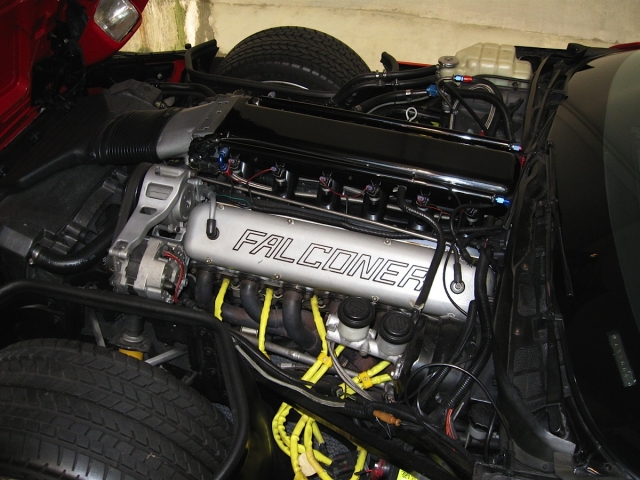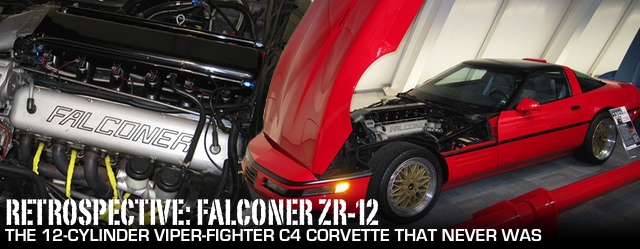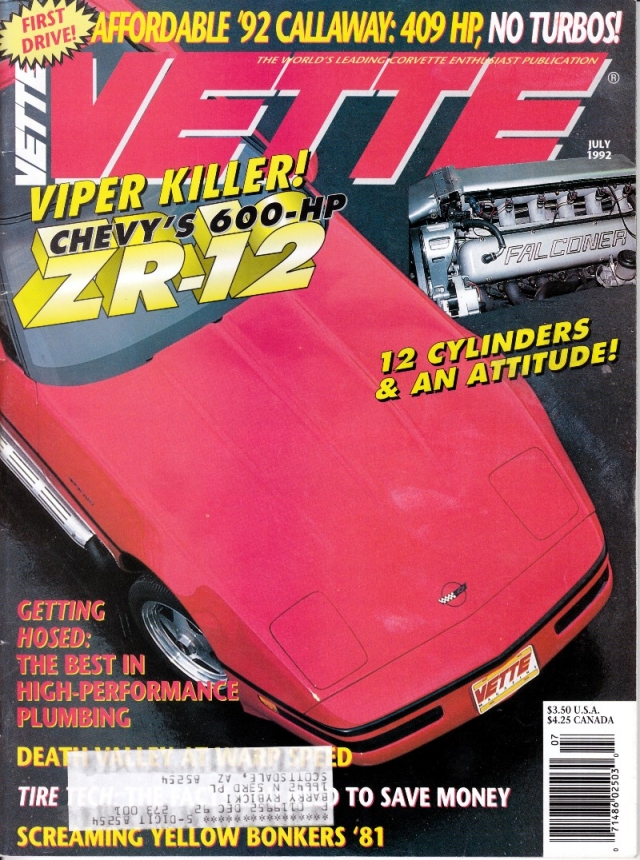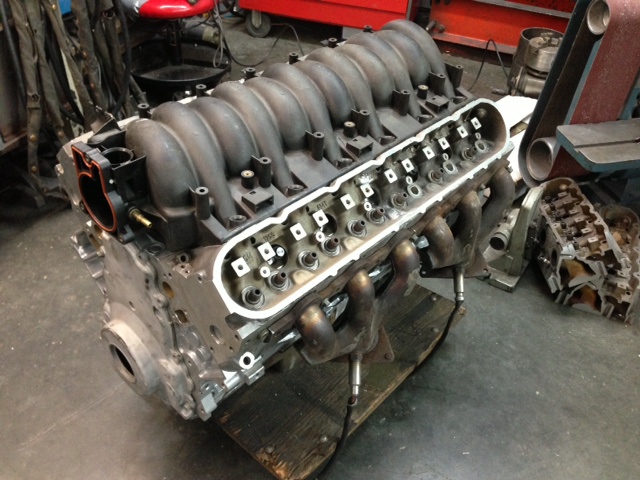Can anyone imagine a V12 Corvette? 12 cylinders of pavement-pounding power packing a punch of over 600 naturally-aspirated horsepower? The Corvette ZR-12 was just that. Well, it was an interesting prototype, but ultimately, not much more than that. The Falconer-powered Corvette ZR-12 made for a fascinating experiment, but as time and technology would prove, you don’t need 12 cylinders to pump over 600 horsepower out of an engine.
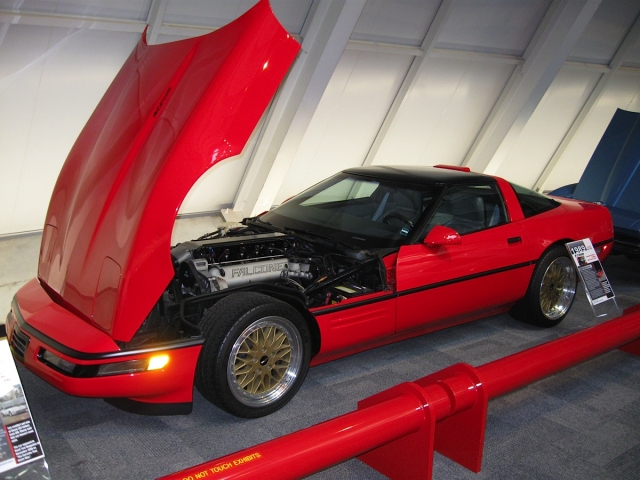
The ZR-12 as it appeared last year in the National Corvette Museum – Note that it was not among the cars damaged in the sinkhole collapse.
Today, cars like the outgoing C6 Corvette ZR1 and the new C7 Z06 prove that Chevrolet didn’t need a 12-cylinder engine to go toe-to-toe with the Dodge (then SRT, and apparently Dodge again) Viper sports car. Still, just playing with the idea of one-upping the Viper in cylinder count was good enough to try, when that car first hit the streets in the early ’90’s.
Battle of the American Sports Cars
Back in the late eighties and the early 1990’s when Chevrolet was in the midst of planning and producing its halo Corvette, the 375 horsepower ZR-1, Dodge was busy preparing its all-new 1992 Viper R/T 10 sports car, jam-packed with a 8.0 liter V10 engine that muscled out a whopping 400 horsepower. That was a real accomplishment back then, especially since automakers were still working their way out of the horsepower malaise of the 1970’s and early 1980’s.
In This Corner: The 1992 Dodge Viper RT/10
The original Viper was a looker, with brute force to back up the swagger. Here are some mechanical specifications:
- 8.0-Liter, OHV, SMPI V10 engine
- Displacement: 488 cu. in. (7990 cc)
- Bore x Stroke: 4.00 x 3.88 (101.6 x 98.5)
- Valve System: OHV, 20 valves, roller-type hydraulic lifters
- Fuel Injection: Sequential, multi-port electronic
- Construction: Aluminum alloy block w/ cast iron liners, aluminum alloy heads
- Compression Ratio: 9.1:1
- Power (SAE net) 400 BHP @ 4600 RPM
- Torque (SAE net) 465 lb-ft (664 Nm) @ 3600 RPM
Like a fair number of performance engines of the time (and even today), the Viper’s V10 required premium fuel. Other interesting facts of note: the Viper RT/10 had no anti-lock brakes and no traction or stability control–things the Viper family acquired in later models. It was meant to be powerful, 3,456-pound handful of muscle-car prowess that only the most skilled drivers could truly drive at its limits (its top speed was 165 MPH, and could do 0-60 in 4.6 seconds). For $50,000, anyone who could afford the Viper would at least have a powerful weekend sports car they could enjoy, if nothing else, “wind in your hair” motoring on the open road.
The original Viper was a raw, unadulterated brute of a sports car, lacking antilock brakes, air conditioning, side windows (yes, side windows) and even a proper hardtop roof. The original Viper R/T 10 (which was, at first only available in a single color–red) was a powerful, menacing-looking automobile, and the original styling still looks striking today. Chevrolet was perfectly fine with the Corvette having a V8 engine (a rotary engine was considered in the 1970’s but never made it into production) which was a hallmark of the car since the mid-1950’s. As a matter of fact, the Corvette debuted in 1953 with a woefully-underpowered inline six cylinder engine, which thankfully didn’t last long.
Had Chevrolet not decided to go with a V8 engine in the Corvette, it probably wouldn’t have lasted in production at all past 1955 or 1956. What if, though, the Corvette had a larger engine with more cylinders – even more than the V10 Dodge Viper R/T 10? What if the Corvette had a V12 nestled under the hood? What results would that produce, and would it be a viable car for Chevrolet and General Motors to produce at all?
Proof of Concept
Enter Ryan Falconer Industries, producers of high powered racing engines with unusual designs. The Falconer V12 used in the Corvette ZR-12 is an aluminum block engine based on small block Chevy architecture, and can be built in displacements ranging from 400 to 600 cubic inches. Designed for marine and aviation applications, the Falconer V12 has even been built in reverse-rotation versions for paired installations.
Because the Corvette is designed to accept V8 engines, there was no way the half-again-as-long-as-a-SBC Falconer V12 engine was going to fit into the engine bay of a C4. Needless to say, some modifications needed to be made before the V12 engine would fit into the ZL-1 mule selected for the conversion.
How was that dilemma solved? A Wixom, Michigan company, SportsFab, extended the front end and engine bay of the ZR-12 Corvette prototype by eight inches (the engine itself is almost nine inches longer), which, of course, made the hood and the entire car longer than a production Corvette. Even with the increased size of the ZR-12’s engine, thanks to the aluminum block with cast-iron liners, it only added 100 extra pounds of weight to the entire car, which in itself was quite an engineering feat.
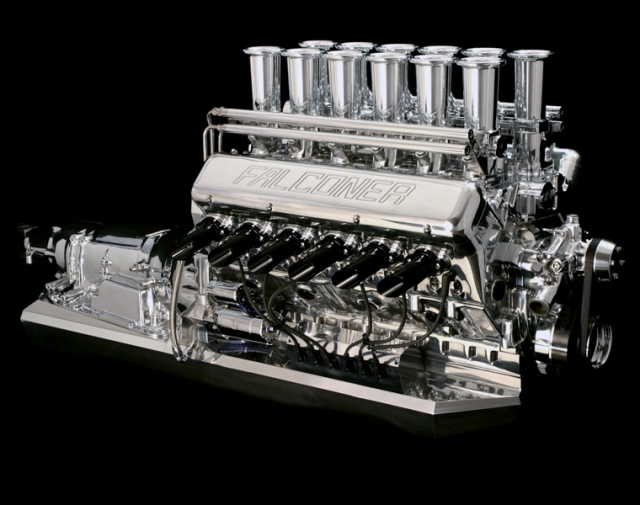
The Falconer V12 can be thought of as a ‘small block Chevy and a half,’ sharing the same dimensions and bore spacing, but with four extra cylinders in the bespoke block.
The Chevrolet Falconer ZR-12 Corvette (also called “Conan the Corvette” in the Motor Trend article) did have its flaws, however. For one thing, it would have been expensive to produce, and Chevrolet already had the specialized ZR-1 as the top-of the-line model.
Checking off the box for RPO ZR1 added another $27,016 on top of the 1990 base Corvette’s $31,979 MSRP, and a V12-powered version would have undoubtedly added another 5-digit number to that total. The C4 ZR-1 suffered from slow sales in part due to its price tag; undoubtedly a V12 Corvette would have been made and sold in extremely limited numbers had it made it to market.
Diamond in the Rough, or Just Rough?
As it stood, the ZR-12 prototype was far from perfect as a road-worthy car. When the Falconer Corvette made some test runs for the media at Arizona’s Firebird Raceway, the day was cut short due to the engine overheating.
It’s unclear whether or not the bugs were ever completely worked out of the Falconer ZR-12 prototype Corvette; however, we can be fairly sure work continued on the car because as it currently sits in the National Corvette Museum, it wears different wheels and a completely reworked exhaust, compared to how it appeared that day at Firebird. What is clear is that this unique prototype gives us a fascinating glimpse at what might have been.
